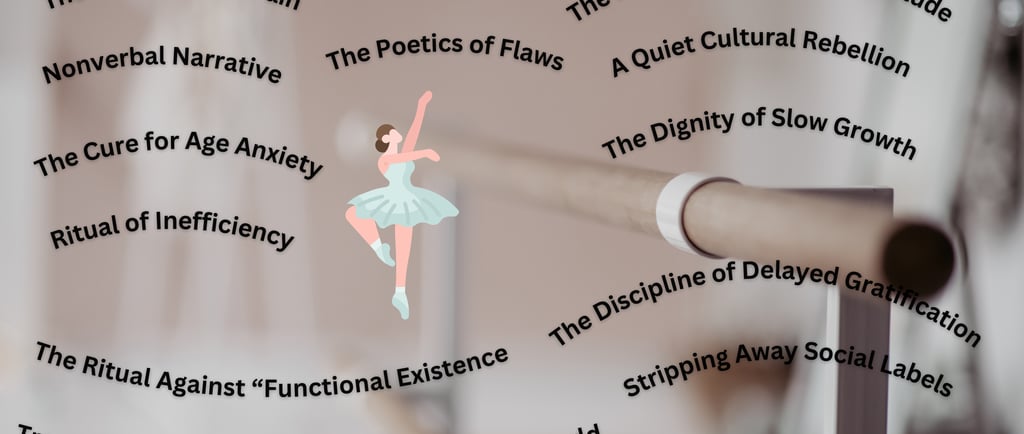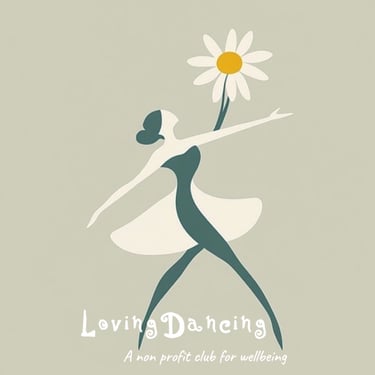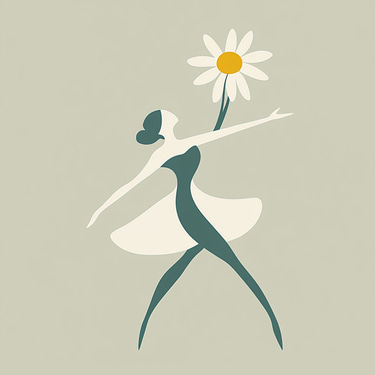Another Perspective on Adult Ballet
In a world obsessed with speed, productivity, and tangible results, why do we willingly dedicate themselves to an art that demands patience, discipline, and years of slow progress? What does it mean to embrace imperfection, endure discomfort, and find poetry in movement without an audience? Perhaps, in each plié and arabesque, we will uncover not just dance, but a new way of understanding life itself.
BALLET 101BELLET 201MENTAL HEALTHME LOVE
Mrs.dancingloving
2/5/20253 min read


1. The Ritual Against “Functional Existence”
Modern adults are trapped in an efficiency-driven rhythm of life, where the body becomes a mere tool, caught in a mechanized routine—stiff necks from long hours of sitting, fingers constantly tapping on keyboards, eyes fixed on screens. Ballet, however, offers a ritual of inefficiency.
Precise Bodily Expression: The positioning of the feet in the five basic positions, the elongated lines of an arabesque—these seemingly “useless” movements serve as a poetic rebellion against mechanical living.
Reframing Time and Space: For 60-90 minutes at the barre, phones are silenced, and the only focus is the dialogue between breath and muscles. This act of concentration is a gentle resistance to an era dominated by fragmentation and distractions.
2. Rebuilding the Connection Between Body and Mind
As people grow older, their relationship with their bodies often becomes alienated: fitness is for weight loss, yoga for healing, running for data, triathlons for validation. Ballet, however, makes the body the very subject of expression.
The Aesthetics of Pain: The bruises inside pointe shoes, the dizziness from turns—these discomforts transform into a clear awareness of limits. The body is no longer just an object to be managed but a companion in exploring boundaries.
Nonverbal Narrative: In workplaces and academia, rational expression dominates. Ballet, however, allows adults to communicate through their bodies—an arc of a port de bras, an elegant movement that speaks more truthfully than words. In this world of dance, the body is not merely a physical entity but a medium of artistic, emotional, and spiritual expression.
3. Redefining the Boundaries of Possibility
Society often labels adults as “fixed,” implying the end of personal growth. However, in the ballet studio, failures and breakthroughs become miniature life experiments.
The Discipline of Delayed Gratification: A single fouetté turn may require 200 failed attempts. The persistence in something one is not immediately good at directly challenges the culture of instant success.
The Cure for Age Anxiety: When a corporate professional executes their first grand jeté, an invisible societal clock suddenly loses its power—“I can still grow.” Success and progress are redefined, allowing adults to reassess their capabilities and potential.
4. A Parallel Universe of Identity
A suited-up executive might be a quiet beginner wiping sweat in the corner, while a homemaker becomes her own queen in an adagio. Ballet provides a space to detach from social roles.
Stripping Away Social Labels: At the barre, one’s value is determined only by muscle control and artistic perception—an unfiltered purity that is a rarity in the adult world.
The Healing of Collective Solitude: When a group of strangers breathes in sync to the sound of a piano, fragmented city dwellers find an unexpected sense of tribal belonging. Ballet becomes an unspoken common language, forming a stark contrast to the alienation often felt in society.


5. The Philosophy of Perfectionism
While ballet seems to pursue the ideal body lines, it ultimately teaches adults to reconcile with imperfection.
The Poetics of Flaws: The injuries of professional dancers, the trembling relevé of amateur learners—these “imperfections” create a more authentic beauty. Much like the Japanese philosophy of wabi-sabi, where imperfection is embraced as beauty, adult ballet teaches one to find the self in flaws and appreciate each small step of progress.
Process as Meaning: Without a stage or applause, adult ballet shifts the focus from outcome to essence—the dance itself is proof of existence.
6. A Quiet Cultural Rebellion
In an age of fast consumption and instant information, choosing to study an art form that takes years to take shape is, in itself, an act of defiance.
The Dignity of Slow Growth: When social media glorifies “learning a dance in a day,” adults who dedicate a year to refining a single pirouette silently challenge the culture of instant gratification.
Translating Classical Spirit into the Modern World: Bringing the courtly art of Louis XIV into the steel and concrete of modern cities—this temporal dissonance is, in itself, a surreal and romantic gesture.
Each plié defies gravity, each stretch breaks through mental constraints, each fall and rise mirrors the essence of life itself. The significance of adult ballet is not in becoming a star on stage, but in becoming the choreographer of one’s own life—finding the strength to keep growing in the most unexpected places, and discovering poetry in persistence that once seemed futile.
DancingLoving - your non profit association for holistic wellbeing
mrs.dancingloving / Mrs. DL


Spotify: community music & podcast sharing
WhatsApp: open community
Instagram: mrs.dancingloving
LinkedIn & Facebook: stay tuned!
Newsletter: sign in in "contact"
